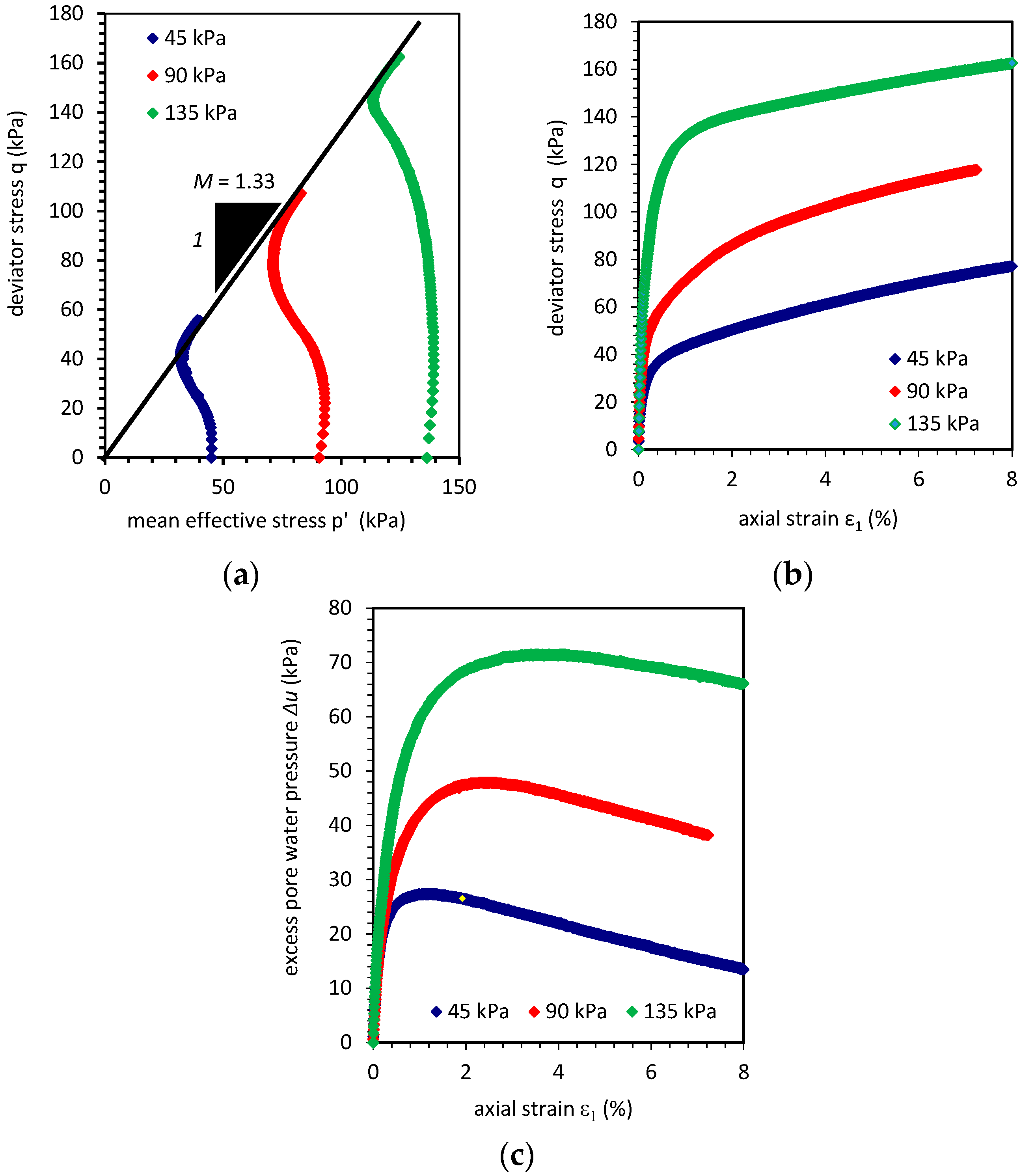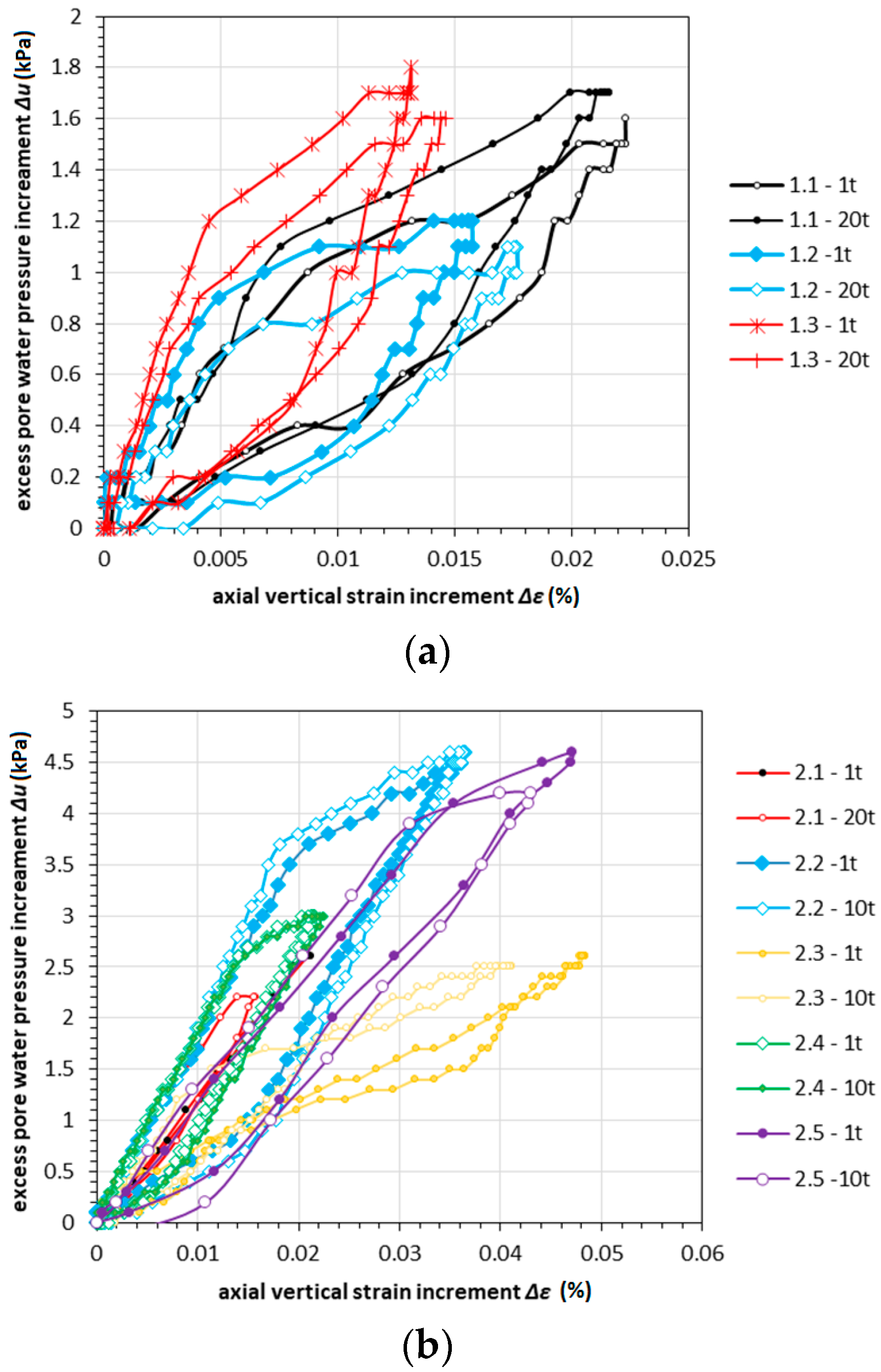Undrained Pore Pressure Development on Cohesive Soil in Triaxial Cyclic Loading
Abstract
:1. Introduction
2. Materials and Methods
2.1. Soil Index Properties
2.2. Monotonic Triaxial Tests
2.3. Soil Sample Properties, Preparation, and Origin
2.4. Test Procedure
3. Results and Discussion
3.1. Isotropically and K0 Consolidated Samples Test Results
3.2. The Effect of Consolidation on the Soil Response to Cyclic Loading
4. Conclusions
Author Contributions
Funding
Conflicts of Interest
References
- Guo, L.; Cai, Y.; Jardine, R.J.; Yang, Z.; Wang, J. Undrained behaviour of intact soft clay under cyclic paths that match vehicle loading conditions. Can. Geotech. J. 2017, 55, 90–106. [Google Scholar] [CrossRef]
- Chai, J.C.; Miura, N. Traffic-load-induced permanent deformation of road on soft subsoil. J. Geotech. Geoenviron. Eng. 2002, 128, 907–916. [Google Scholar] [CrossRef]
- Andersen, K.H. Bearing capacity under cyclic loading—Offshore, along the coast, and on land. The 21st Bjerrum Lecture presented in Oslo, 23 November 2007. Can. Geotech. J. 2009, 46, 513–535. [Google Scholar] [CrossRef]
- Ishihara, K.; Tatsuoka, F.; Yasuda, S. Undrained deformation and liquefaction of sand under cyclic stresses. Soils Found. 1975, 15, 29–44. [Google Scholar] [CrossRef]
- Abdelkrim, M.; Bonnet, G.; De Buhan, P. A computational procedure for predicting the long term residual settlement of a platform induced by repeated traffic loading. Comput. Geotech. 2003, 30, 463–476. [Google Scholar] [CrossRef] [Green Version]
- Bogusz, W.; Godlewski, T. Philosophy of geotechnical design in civil engineering—Possibilities and risks. Bull. Pol. Acad. Sci. Tech. Sci. 2019, 67, 289–306. [Google Scholar]
- Chiou, J.S.; Lin, H.S.; Yeh, F.Y.; Sung, Y.C. Plastic settlement evaluation of embedded railroads under repeated train loading. J. GeoEng. 2016, 11, 97–107. [Google Scholar]
- Tang, L.; Chen, H.; Sang, H.; Zhang, S.; Zhang, J. Determination of traffic-load-influenced depths in clayey subsoil based on the shakedown concept. Soil Dyn. Earthq. Eng. 2015, 77, 182–191. [Google Scholar] [CrossRef]
- Kawalec, J.; Grygierek, M.; Koda, E.; Osiński, P. Lesson learned on geosynthetics applications in road structures in Silesia mining region in Poland. Appl. Sci. 2019, 9, 1122. [Google Scholar] [CrossRef]
- Bian, X.; Jiang, H.; Chen, Y. Accumulative deformation in railway track induced by high-speed traffic loading of the trains. Earthq. Eng. Eng. Vib. 2010, 9, 319–326. [Google Scholar] [CrossRef]
- Uzan, J. Permanent deformation in flexible pavements. J. Transp. Eng. 2004, 130, 6–13. [Google Scholar] [CrossRef]
- Cai, Y.; Sun, Q.; Guo, L.; Juang, C.H.; Wang, J. Permanent deformation characteristics of saturated sand under cyclic loading. Can. Geotech. J. 2015, 52, 795–807. [Google Scholar] [CrossRef]
- Shi, W.; Wang, J.; Guo, L.; Hu, X.; Fu, H.; Jin, J.; Jin, F. Undrained cyclic behavior of overconsolidated marine soft clay under a traffic-load-induced stress path. Mar. Georesour. Geotechnol. 2018, 36, 163–172. [Google Scholar] [CrossRef]
- Chiaradonna, A.; Tropeano, G.; d’Onofrio, A.; Silvestri, F. A simplified method for pore pressure buildup prediction: From laboratory cyclic tests to the 1D soil response analysis in effective stress conditions. Procedia Eng. 2016, 158, 302–307. [Google Scholar] [CrossRef]
- Chiaradonna, A.; Tropeano, G.; d’Onofrio, A.; Silvestri, F. Development of a simplified model for pore water pressure build-up induced by cyclic loading. Bull. Earthq. Eng. 2018, 16, 3627–3652. [Google Scholar] [CrossRef]
- Park, T.; Park, D.; Ahn, J.K. Pore pressure model based on accumulated stress. Bull. Earthq. Eng. 2015, 13, 1913–1926. [Google Scholar] [CrossRef]
- Xu, C.; Chen, Q.; Luo, W.; Liang, L. Evaluation of Permanent Settlement in Hangzhou Qingchun Road Crossing-River Tunnel under Traffic Loading. Int. J. Geomech. 2018, 19, 06018037. [Google Scholar] [CrossRef]
- Guoxing, C.; Qi, W.; Tian, S.; Kai, Z.; Enquan, Z.; Lingyu, X.; Yanguo, Z. Cyclic Behaviors of Saturated Sand-Gravel Mixtures under Undrained Cyclic Triaxial Loading. J. Earthq. Eng. 2018, 1–34. [Google Scholar] [CrossRef]
- Salvatore, E.; Ando, E.; Proia, R.; Modoni, G.; Viggiani, G. Effect of strain localization on the response of granular materials subjected to monotonic and cyclic triaxial tests. Ital. Geotech. J. 2018, 52, 30–43. [Google Scholar]
- Salvatore, E.; Spacagna, R.L.; Andò, E.; Ochmanski, M. Geostatistical analysis of strain localization in triaxial tests on sand. Géotech. Lett. 2019, 9, 1–6. [Google Scholar] [CrossRef]
- Kucharczyk, K.; Głuchowski, A.; Miturski, M.; Sas, W. Influence of Load Frequency on Cohesive Soil Respond. Geosciences 2018, 8, 468. [Google Scholar] [CrossRef]
- Liu, X.; Zhang, X.; Wang, H.; Jiang, B. Laboratory testing and analysis of dynamic and static resilient modulus of subgrade soil under various influencing factors. Constr. Build. Mater. 2019, 195, 178–186. [Google Scholar] [CrossRef]
- Sas, W.; Głuchowski, A.; Gabryś, K.; Soból, E.; Szymański, A. Resilient modulus characterization of compacted cohesive subgrade soil. Appl. Sci. 2017, 7, 370. [Google Scholar] [CrossRef]
- Mortezaie, A.R.; Vucetic, M. Effect of frequency and vertical stress on cyclic degradation and pore water pressure in clay in the NGI simple shear device. J. Geotech. Geoenviron. Eng. 2013, 139, 1727–1737. [Google Scholar] [CrossRef]
- Gu, C.; Wang, J.; Cai, Y.Q.; Yang, Z.X.; Gao, Y.F. Undrained cyclic triaxial behavior of saturated clays under variable confining pressure. Soil Dyn. Earthq. Eng. 2012, 40, 118–128. [Google Scholar] [CrossRef]
- Guo, L.; Wang, J.Y.; Cai, Q.; Liu, H.L.; Gao, Y.F.; Sun, H.L. Undrained deformation behavior of saturated soft clay under long-term cyclic loading. Soil Dyn. Earthq. Eng. 2013, 50, 28–37. [Google Scholar] [CrossRef]
- Qian, J.G.; Wang, Y.G.; Yin, Z.Y.; Huang, M.S. Experimental identification of plastic shakedown behavior of saturated clay subjected to traffic loading with principal stress rotation. Eng. Geol. 2016, 214, 29–42. [Google Scholar] [CrossRef]
- Ichii, K.; Mikami, T. Cyclic threshold shear strain in pore water pressure generation in clay in situ samples. Soils Found. 2018, 58, 756–765. [Google Scholar] [CrossRef]
- Krechowiecki-Shaw, C.J.; Jefferson, I.; Royal, A.; Ghataora, G.S.; Alobaidi, I.M. Degradation of soft subgrade soil from slow, large, cyclic heavy-haul road loads: A review. Can. Geotech. J. 2016, 53, 1435–1449. [Google Scholar] [CrossRef]
- Abeywickrama, A.; Indraratna, B.; Rujikiatkamjorn, C. Excess Pore-Water Pressure Generation and Mud Pumping in Railways Under Cyclic Loading. In Geotechnics for Transportation Infrastructure; Springer: Singapore, 2019; pp. 371–383. [Google Scholar]
- Lei, H.; Li, B.; Lu, H.; Ren, Q. Dynamic deformation behavior and cyclic degradation of ultrasoft soil under cyclic loading. J. Mater. Civ. Eng. 2016, 28, 04016135. [Google Scholar] [CrossRef]
- Yang, Q.; Ren, Y.; Niu, J.; Cheng, K.; Hu, Y.; Wang, Y. Characteristics of soft marine clay under cyclic loading: A review. Bull. Eng. Geol. Environ. 2018, 77, 1027–1046. [Google Scholar] [CrossRef]
- Wang, J.; Guo, L.; Cai, Y.; Xu, C.; Gu, C. Strain, and pore pressure development on soft marine clay in triaxial tests with a large number of cycles. Ocean Eng. 2013, 74, 125–132. [Google Scholar] [CrossRef]
- Ren, X.W.; Xu, Q.; Teng, J.; Zhao, N.; Lv, L. A novel model for the cumulative plastic strain of soft marine clay under long-term low cyclic loads. Ocean Eng. 2018, 149, 194–204. [Google Scholar] [CrossRef]
- Zeng, L.L.; Hong, Z.S.; Han, J. Experimental investigations on discrepancy in consolidation degrees with deformation and pore pressure variations of natural clays. Appl. Clay Sci. 2018, 152, 38–43. [Google Scholar] [CrossRef]
- Indraratna, B.; Ni, J.; Rujikiatkamjorn, C.; Zhong, R. A new model for describing the behaviour of soft soils under cyclic loading. In Proceedings of the 12th Australia New Zealand Conference on Geomechanics (ANZ 2015): The Changing Face of the Earth—Geomechanics & Human Influence, Auckland, New Zealand, 22–25 February 2015; pp. 1–8. [Google Scholar]
- Zografou, D.; Gourvenec, S.; O’Loughlin, C. Vertical cyclic loading response of shallow skirted foundation in soft normally consolidated clay. Can. Geotech. J. 2018, 56, 473–483. [Google Scholar] [CrossRef]
- Sun, L.; Cai, Y.; Gu, C.; Wang, J.; Guo, L. Cyclic deformation behaviour of natural K0-consolidated soft clay under different stress paths. J. Cent. South Univ. 2015, 12, 4828–4836. [Google Scholar] [CrossRef]
- Kenig, K. Litologia glin morenowych na Niżu Polskim-podstawowe metody badawcze. Biul. Państwowego Inst. Geol. 2009, 437, 1–57. [Google Scholar]
- Bajda, M.; Falkowski, T. Badania geotechniczne w ocenie budowy geologicznej fragmentu Skarpy Warszawskiej w rejonie ulicy Tamka. Landf. Anal. 2014, 26, 77–84. [Google Scholar] [CrossRef]
- EN 1997-2:2007 Geotechnical Design—Part 2: Ground Investigation and Testing. Available online: http://sklep.pkn.pl/pn-en-1997-2-2007e.html (accessed on 14 March 2007).
- ISO 17892-4:2016 Geotechnical Investigation and Testing—Laboratory Testing of Soil—Part 4: Determination of Particle Size Distribution. Available online: http://sklep.pkn.pl/pn-en-iso-17892-4-2017-01e.html (accessed on 18 January 2017).
- ASTM D698-12e1. Standard Test Methods for Laboratory Compaction Characteristics of Soil Using Standard Effort (12 400 ft-lbf/ft3 (600 kN-m/m3)). Annual Book of ASTM Standards, USA. 2008. Available online: https://www.techstreet.com/standards/astm-d5254-d5254m-92-2010-e1?product_id=1751704 (accessed on 8 January 2010).
- Seed, H.B.; Martin, P.P.; Lysmer, J. The Generation and Dissipation of Pore Water Pressures during Soil Liquefaction; Report No. UCB/EERC-75/26; Earthquake Engineering Center, University of California: Berkeley, CA, USA, 1975. [Google Scholar]
- Yasuhara, K.; Yamanouchi, T.; Hirao, K. Ciclyc strength and deformataion of normally consolidated clay. Soils Found. 1982, 22, 77–91. [Google Scholar] [CrossRef]
















| Index Properties | Value |
|---|---|
| Specific gravity, Gs (g/cm3) | 2.67 |
| Optimal moisture content, wopt (%) | 12.3 |
| Maximal dry density, ρd max (g/cm3) | 1.96 |
| Liquid limit, wL (%) | 42.0 |
| Plasticity index, IP (%) | 18.4 |
| Clay fraction, fCl (%) | 19 |
| Silt fraction, fSi (%) | 41 |
| Sand fraction, fSa (%) | 40 |
| Index Properties | 1.1 | 1.2 | 1.3 | 2.1 | 2.2 | 2.3 | 2.4 | 2.5 |
|---|---|---|---|---|---|---|---|---|
| Moisture content, w (%) | 14.75 | 12.62 | 14.33 | 12.34 | 11.14 | 12.66 | 6.07 | 9.38 |
| Dry density, ρd (g/cm3) | 1.89 | 1.95 | 1.89 | 1.96 | 1.92 | 1.94 | 2.10 | 1.91 |
| Void ratio, e0 (−) | 0.414 | 0.345 | 0.412 | 0.333 | 0.399 | 0.379 | 0.276 | 0.400 |
| Stress Component | 1.1 | 1.2 | 1.3 | 2.1 | 2.2 | 2.3 | 2.4 | 2.5 |
|---|---|---|---|---|---|---|---|---|
| Maximal deviator stress, qmax (kPa) | 43.6 | 46.0 | 43.2 | 117.3 | 100.9 | 101.5 | 169.9 | 79.6 |
| Minimal deviator stress, qmin (kPa) | 35.4 | 37.0 | 35.2 | 96.0 | 74.0 | 80.7 | 138.3 | 53.1 |
| Deviator stress median, qm (kPa) | 39.5 | 41.5 | 39.2 | 106.7 | 87.5 | 91.1 | 154.1 | 66.4 |
| Deviator stress amplitude, qa (kPa) | 4.1 | 4.5 | 4.0 | 10.7 | 13.5 | 10.4 | 15.8 | 13.3 |
| Effective confining pressure, σ′3 (kPa) | 45.0 | 90.0 | 135.0 | 65.0 | 125.0 | 139.7 | 94.2 | 44.9 |
| Cyclic stress ratio, CSR (−) | 0.484 | 0.256 | 0.160 | 0.902 | 0.403 | 0.363 | 0.901 | 0.886 |
© 2019 by the authors. Licensee MDPI, Basel, Switzerland. This article is an open access article distributed under the terms and conditions of the Creative Commons Attribution (CC BY) license (http://creativecommons.org/licenses/by/4.0/).
Share and Cite
Głuchowski, A.; Soból, E.; Szymański, A.; Sas, W. Undrained Pore Pressure Development on Cohesive Soil in Triaxial Cyclic Loading. Appl. Sci. 2019, 9, 3821. https://doi.org/10.3390/app9183821
Głuchowski A, Soból E, Szymański A, Sas W. Undrained Pore Pressure Development on Cohesive Soil in Triaxial Cyclic Loading. Applied Sciences. 2019; 9(18):3821. https://doi.org/10.3390/app9183821
Chicago/Turabian StyleGłuchowski, Andrzej, Emil Soból, Alojzy Szymański, and Wojciech Sas. 2019. "Undrained Pore Pressure Development on Cohesive Soil in Triaxial Cyclic Loading" Applied Sciences 9, no. 18: 3821. https://doi.org/10.3390/app9183821
APA StyleGłuchowski, A., Soból, E., Szymański, A., & Sas, W. (2019). Undrained Pore Pressure Development on Cohesive Soil in Triaxial Cyclic Loading. Applied Sciences, 9(18), 3821. https://doi.org/10.3390/app9183821







